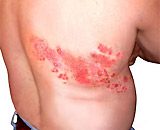Recovering from chickenpox does not mean that children have escaped the “claws” of the Varicella Zoster virus. This virus can remain dormant in the body for decades, waiting for the opportunity to re-emerge and cause shingles (commonly known as “giời leo”) with persistent and severe pain.
 |
| Lesions in shingles (Photo: VNE) |
Dr. Pham Thi Huong from the Dermatology Department at Hanoi Medical University states that approximately 1 in 4 individuals infected with the Varicella Zoster virus—the agent responsible for chickenpox—will develop shingles before the age of 85. This risk is significantly higher in individuals with weakened immune systems, such as cancer patients and those infected with HIV, and increases with age. Individuals who contract chickenpox during their first year of life are also 3 to 20 times more likely to develop shingles compared to those who contract it later.
The initial symptoms of shingles include chest pain lasting 3-4 days, pain on one side of the body, and a burning sensation, followed by the appearance of blisters in a linear pattern also on one side, along the nerves. The most common locations are the chest (following intercostal nerves), neck, face, and back (following the sciatic nerve). The blisters contain fluid, which after a few days may become pus, dry out, and eventually scab over. Patients constantly feel pain; the older they are, the more severe the pain.
Shingles can lead to complications such as conjunctivitis, keratitis, uveitis, urinary tract disorders, facial paralysis, encephalitis, and meningitis.
The most frightening complication is postherpetic neuralgia, often seen in older adults with dry, thin skin. This condition involves persistent pain in the area of skin where the blisters healed (4-6 weeks), and is very difficult to treat. At this point, patients endure continuous pain likened to stabbing or cutting, which can last for months, years, or even a lifetime. To prevent this complication, patients diagnosed with shingles should receive antiviral treatment. Medications also help speed up the healing of scars, reduce the severity of the disease, and shorten the duration of inflammation and acute pain.
The best way to prevent shingles is by preventing chickenpox through vaccination. Dr. Huong notes that the currently available chickenpox vaccine is Varilrix from the United States, costing around 300,000 VND per dose, and can be administered to children from 12 months old. Children over 13 years old require two doses spaced 4-8 weeks apart.
The vaccine begins to take effect 3-5 days after administration; considering the incubation period is 7-21 days, it is still timely to vaccinate if exposed to an infected person. Those who have been vaccinated rarely contract chickenpox; if they do, it is usually mild with very few spots and no complications.
Hai Ha


















































